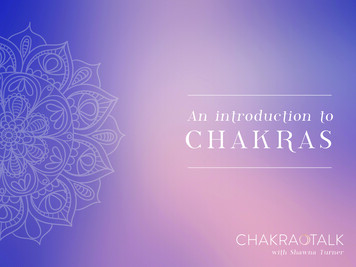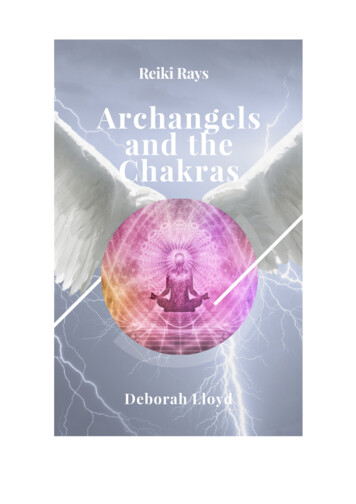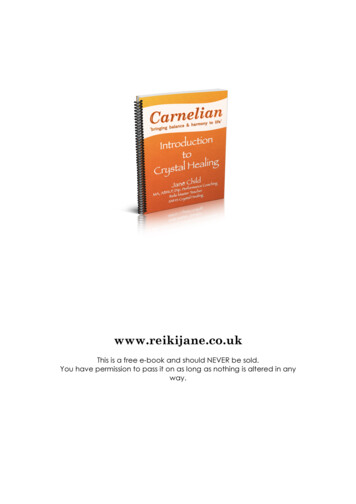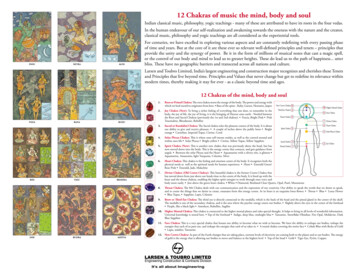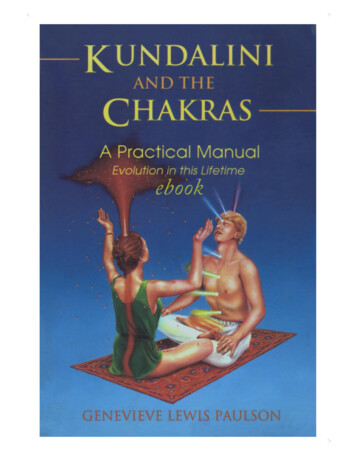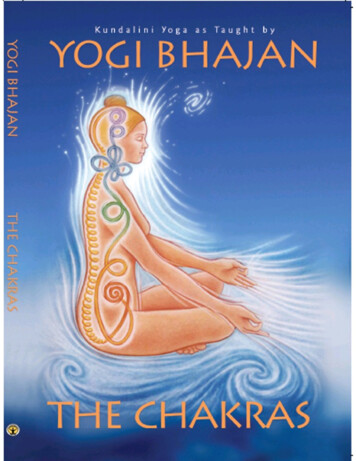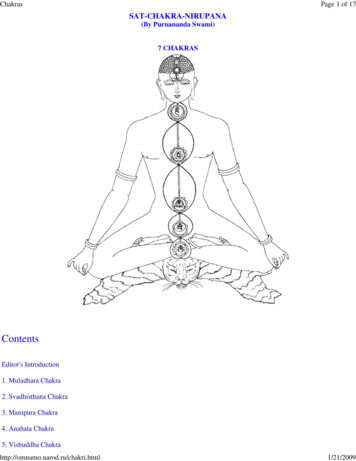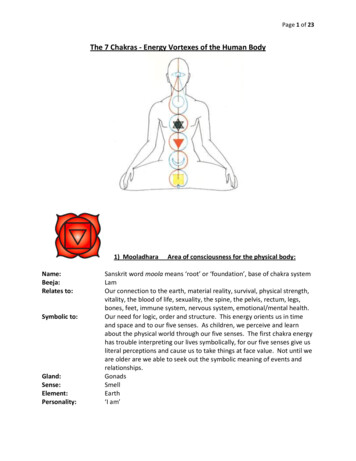
Transcription
Page 1 of 23The 7 Chakras - Energy Vortexes of the Human Body1) MooladharaName:Beeja:Relates to:Symbolic to:Gland:Sense:Element:Personality:Area of consciousness for the physical body:Sanskrit word moola means ‘root’ or ‘foundation’, base of chakra systemLamOur connection to the earth, material reality, survival, physical strength,vitality, the blood of life, sexuality, the spine, the pelvis, rectum, legs,bones, feet, immune system, nervous system, emotional/mental health.Our need for logic, order and structure. This energy orients us in timeand space and to our five senses. As children, we perceive and learnabout the physical world through our five senses. The first chakra energyhas trouble interpreting our lives symbolically, for our five senses give usliteral perceptions and cause us to take things at face value. Not until weare older are we able to seek out the symbolic meaning of events andrelationships.GonadsSmellEarth‘I am’
Page 2 of 23Balanced Energy:Excessive Energy:Deficient Energy:Centered, grounded, healthy, fully alive, unlimited physical energy,manifesting abundance, master of oneselfEgotistic, domineering, greedy, addicted to wealth, indiscriminate use ofsexual energy, nervous sexual energyLack of confidence, no grounded in physical reality, weak, can’t achievegoals, self destructive, feeling unloved or abandonedThe energy content of the first or Tribal chakra is tribal power. The word tribe is not only asynonym for family but an archetype, and as such it has connotations beyond its moreconventional definition. Archetypally the word tribal connotes group identity, group force,group willpower, and group belief patterns. The first chakra grounds us, it is our connection totraditional familial beliefs that support the formation of identity and a sense of belonging to agroup of people in a geographic location.We begin to discover that ‘All Is One’ as we start life within our tribe or family. To bepart of a tribe is a primal need, since we are completely dependent upon our tribe for basicsurvival needs: food, shelter and clothing. As tribal beings, we are energetically designed to livetogether, to create together, to be together, to need one another. Each of our tribalenvironments – from our biological tribe, to the tribe we form with co-workers, to our tribalbonds with friends – provides the essential physical settings within which we can explore thecreative power of this truth.Regardless of the “truth” of familial beliefs, every one of them directs a measure of ourenergy into an act of creation. Each belief, each action has a direct consequence. When weshare belief patterns with groups of people, we participate in energy and physical eventscreated by those groups. This is the creative, symbolic expression of the sacred truth All Is One.To connect to the energy of your first chakra, focus your attention for a few moments onsomething tribal that triggers an emotional response in you: listening to the national anthem observing a military spectacle watching an athlete receive a gold medal at the Olympics witnessing the marriage of someone you care about learning that a child has been named after youNo one begins life as a conscious “individual” with conscious will power. That identitycomes much later and develops in stages from childhood through adulthood. Beginning life asa part of a tribe, we become connected to our tribal consciousness and collective willpower byabsorbing its strengths and weaknesses, beliefs, superstitions and fears. Through ourinteractions with family and other groups, we learn the power life of sharing a belief with otherpeople. We also learn how painful it can be to be excluded from a group and its energy. Welearn as well the power of sharing a moral and ethical code handed down from generation togeneration. This code of behaviour guides children of the tribe during their development years,providing a sense of dignity and belonging.Questions for Self-Examination:1. What belief patterns did you inherit from your family?
Page 3 of 232. Which of those belief patterns that still have authority in your thinking can you acknowledgeare no longer valid?3. What superstitions do you have? Which have more authority over you than your ownreasoning ability?4. Do you have a personal code of honour? What is it?5. Have you ever compromised your sense of honour? If so, have you taken steps to heal it?6. Do you have any unfinished business with your family members? If so, list the reasons thatprevent you from healing your family relationships.7. List all the blessings that you feel came from your family?8. If you are now raising a family of your own, list the qualities that you would like yourchildren to learn from you.9. What tribal traditions and rituals do you continue for yourself and your family?10. Describe the tribal characteristics within yourself that you would like to strengthen anddevelop.2) Swadhisthana Area of consciousness for the emotional body:Name:Beeja:Relates to:Gland:Sense:Element:Personality:Balanced Energy:Excessive Energy:Deficient Energy:Sanskrit word swa means ‘one’s own’ and adisthana means ‘dwellingplace or residence’Vamthe water element in the physical body, the sexual organs, large intestine,lower vertebrae, pelvis, hip, bladder, the lymphatic system, themammary glands, and eliminative organs, the emotions, passion,feelings, imaginationFemale reproductive organsTasteWater‘I feel’ or ‘I desire’Friendly, optimistic, concerned for others, sense of belonging, creative,imaginative, intuitive, attuned to your own feelings, sense of humourEmotionally explosive, aggressive, overly ambitious, manipulative, caughtup in illusion, overindulgent, self serving, obsessive thoughts of sex, seepeople as sex objects.Extremely shy, timid, immobilized by fear, overly sensitive, self-negating,resentful, buried emotions, burdened by guilt, distrustful, clinging, guiltyabout sex, difficult conceiving, abused, frigid or impotent
Page 4 of 23The second chakra is the partnership chakra. Its energy begins to pulsate and become distinctaround the age of seven. At the age of children start interacting with other children and adults,more independently of their parents and outside the home environment. Through these initialinteractions they begin to individuate, form relationships, and explore their power of choice.With the second chakra energy shifts from obeying tribal authority to discovering otherrelationships that satisfy personal, physical needs.This chakra resonates to our need for relationships with other people and our need tocontrol to some extent the dynamics of our physical environment. All the attachments bywhich we maintain control over our external lives, such as authority, other people, or money,are linked through this chakra to our energy field and physical body. The illnesses that originatein this energy center are activated by the fear of losing control. The energy in this chakraenables us to generate a sense of personal identity and protective psychological boundaries. Aswe continually assess our personal strength in regard to the external world and its physicalseductive forces – such as sex, money, addictive substances, or other people – the secondchakra energy of a healthy physical ego keeps us able to interact with the world without havingto negotiate or sell ourselves; it is the energy of self-sufficiency, a survival instinct for being inthe world.This chakra has procreative energy that is both biological and spiritual: we desire tocreate children and also to bring our creative ideas into physical form, which is crucial to ourphysical health as to our spiritual.The primary fears in this chakra are the loss of control, or being controlled by another,through the dominating power of events or conditions such as addiction, rape, betrayal,impotence, financial loss, abandonment by our primary partner or professional colleagues.The primary strengths are the ability to survive financially and physically on one’s ownto defend and protect oneself; the ‘fight or flight’ instinct; the ability to take risks; the resilienceto recover from loss whether of family members, partners, property, occupation, or finances;the power to rebel and re-establish a life; and personal and professional decision-making abilityand talent.The sacred truth inherent in the second chakra is ‘Honour One Another’. This truthapplies to our interactions with each other and with all forms of life. From a spiritualperspective every relationship we develop, from the most casual to the most intimate, servesthe purpose of helping us to become more conscious. Some relationships are necessarilypainful because learning about ourselves and facing our own limitations are not things we tendto do with enthusiasm. We often need to be spiritually ‘set up’ for such encounters.Spiritual messengers bring into our lives-and we into theirs-revelations about our ownstrengths and weaknesses. From relationships within the home to those at work to communityor political activity, no union is without spiritual value; each helps us grow as individuals. Wecan more easily see the symbolic value of our relationships when we release our compulsion tojudge what and who has value and instead focus on honouring the person and the task withwhich we are involved.The second chakra’s energy has an inherent duality. The unified energy of the firstchakra, represented by the tribal mind, becomes divided into polarities in the second chakra.The division of forces has been given many names: yin/yang, anima/animus, male/female,sun/moon. Understanding the significance of these opposites is the key to working with second
Page 5 of 23chakra issues. The energies of the sefirah of Yesod and the sacrament of Communion combinewith these dual energies of the second chakra to ensure that we “attract” to ourselvesrelationships that help us come to know ourselves. Well known expressions such as “Likeattracts like” and “When the student is ready, the teacher will appear” acknowledge that anenergy working “behind the scenes” seems to organize when and where we meet people – andalways at the right time. The spiritual challenge of this second chakra is to learn to interactconsciously with others: to form unions with people who support our development and torelease relationships that handicap our growth.Physical science recognizes second chakra energy as the law of cause and effect (forevery action, there is an equal and opposite reaction) and the law of magnetism, these lawsmean that we generate patterns of energy that attract people who are opposite us in someway, who have something to teach. Nothing is random; prior to every relationship we haveever formed, we opened the door with energy that we were generating. Choice is born out ofopposites, and the duality of the second chakra is forever challenging us to make choices in aworld of opposing sides, of positive and negative energy patterns. Every choice we makecontributes to a subtle current of our energy to our universe, which is responsive to theinfluence of human consciousness.In summary: Second chakra energy gives us our basic survival instincts and intuitions, aswell as our desire to create music, art, poetry, and architecture, and the curiosity to investigatenature in science and medicine. Our creative energy draws us into an internal dialogue with thepolarities of the self, our self, our conflicting inclinations, and it compels us to form externalrelationships to resolve these polarities.Questions for Self-Examination:1. How do you define creativity? Do you consider yourself a creative person? Do you followthrough on your creative ideas?2. How often do you direct your creative energies into negative paths of expression? Do youexaggerate or embellish “facts” to support your point of view?3. Are you comfortable with your sexuality? If not, are you able to work toward healing yoursexual imbalances? Do you use people for sexual pleasure, or have you felt used? Are youstrong enough to honor your sexual boundaries?4. Do you negotiate your ethics depending upon your circumstances?5. Do you have an impression of God as a force that exerts justice in your life?6. Are you a controlling person? Do you engage in power plays in your relationships? Are youable to see yourself clearly in circumstances related to power and money?7. Does money have authority over you? Do you make compromises that violate your innerself for the sake of financial security?8. How often do survival fears dictate your choices?9. Are you strong enough to master your fears concerning finances and physical survival, or dothey control you and your attitudes?10. What goals do you have for yourself that you have yet to pursue? What stands in the wayof your acting upon those goals?
Page 6 of 233) ManipuraName:Beeja:Relates to:Gland:Sense:Element:Personality:Balanced Energy:Excessive Energy:Deficient Energy:Area of consciousness for the mental bodyManipura is derived from two Sanskrit words: mani meaning ‘jewel’ andpura meaning ‘city’. Manipura literally means ‘city of jewels’.RamPersonal power, individual expression in the earth, the ability to ‘digestlife’, the fire element, the conscious (waking) mind, self-image, digestiveorgans, diaphragm, the breath, solar plexusAdrenalsSightFire‘I will’Outgoing, cheerful, self respect, respect for others, strong sense ofpersonal power, have found your gift, able to digest life, able to digestfood, skillful, intelligent, relaxed, spontaneous, expressive, take on newchallenges, enjoy physical activity, enjoy good foodJudgemental, workaholic, perfectionist, overly intellectual, demanding,resentful of authority, a need for drugs to relax, superiority complexDepressed, lack of confidence, worry about what others think, confused,feeling that others control your life, poor digestion, afraid of being alone,need constant reassurance, jealous, distrustfulThird chakra energy, the energy of personal power chakra, becomes the dominant vibration inour development during puberty. It assists us further in the process of individuation, of forminga self , ego and personality separate from our inherited identity. This energy center alsocontains most issues related to the development of personal power and self-esteem.The third chakra completes the physical trilogy of the human energy system. Likechakras one and two, it primarily relates to a physical form of power. Where the first chakraresonates to group or tribal power, and where the second chakra resonates to the flow ofpower between the self and others, the third chakra relates to our personal power in relationto the external world.The third chakra mediates between the primary external (which is characteristic of thefirst and second chakras) and the internalization of consciousness. The first chakra has anexternal center of gravity and is always located within a group mind. The second chakra, too,has an external gravitational center but focuses on relationships and their effects on us. In thethird chakra, however, the gravitational center is partly internalized, as our focus shifts fromhow we related to people around us to how we relate to and understand ourselves.
Page 7 of 23Primary fears: Fears of rejection, criticism, looking foolish, and failing to meet one sresponsibilities; all fears related to physical appearance, such as fear of obesity, baldness, oraging; fears that others will discover our secrets. The illnesses that originate here are activatedby issues related to self-responsibility, self-esteem, fear of rejection, and an over sensitivity tocriticism.Primary strengths: Self-esteem, self-respect, and self-discipline; ambition, the ability togenerate action, and the ability to handle a crisis; the courage to take risks; generosity, ethics,and strength of character.The energies that come together in this chakra have but one spiritual goal: to help usmature in our self-understanding – the relationship we have with ourselves, and how we standon our own and take care of ourselves. We all have faced or will face an experience thatreveals to us our own internal strengths and weaknesses as separate from the influence of ourelders. The spiritual quality inherent in the third chakra compels us to create an identity apartfrom our tribal self. As we develop a sense of self, our intuitive voice becomes our natural andconstant source of guidance.How we feel about ourselves, whether we respect ourselves, determines the quality ofour life, our capacity to succeed in business, relationships, healing, and intuitive skills. Selfunderstanding and acceptance, the bond we form with ourselves, is in many ways the mostcrucial spiritual challenge we face. In truth, if we do not like ourselves, we will be incapable ofmaking healthy decisions. Instead, we will direct all of our personal power for decision-makinginto the hands of someone else: someone whom we want to impress, or someone beforewhom we think we must weaken ourselves to gain physical security. People who have a lowsense of self-esteem attract relationships and occupational situations that reflect and reinforcethis weakness. No one is born with healthy self-esteem. We must earn this quality in theprocess of living, as we face our challenges one at a time.Look at the boundaries of your body; are you strong or weak? Able or handicapped?Beautiful or scarred? Too tall or too short? From a spiritual perspective, any and all physicalassets and limitations are illusory, mere life props . Yet a person s acceptance of or resistanceto them is critical to entering spiritual adulthood. From a spiritual perspective, in fact, theentire physical world is nothing more than our classroom, but the challenge to each of us in thisclassroom is: Given your particular body, environment, and beliefs, will you make choices thatenhance your spirit or those that drain your power into the physical illusion around you?Questions for Self-Examination:1. Do you like yourself? If not, what don’t you like about yourself, and why? Are you activelyworking to change the things about yourself that you don’t like?2. Are you honest? Do you sometimes misrepresent the truth? If so, why?3. Are you critical of others? Do you need to blame others as a way of protecting yourself?4. Are you able to admit it when you are wrong? Are you open to feedback from other peopleabout yourself?5. Do you need the approval of others? If so, why?6. Do you consider yourself strong or weak? Are you afraid of taking care of yourself?7. Have you ever allowed yourself to be in a relationship with a person you didn t love, but itseemed better than being alone?
Page 8 of 238. Do you respect yourself? Can you decide to make changes in your lifestyle and then stick toyour commitment?9. Are you afraid of responsibility? Or do you feel responsible for everything and everyone?10. Are you continually wishing your life were different? If so, are you doing anything tochange it, or have you resigned yourself to your situation?4) AnahataName:Beeja:Relates to:Gland:Sense:Element:Personality:Balanced Energy:Excessive Energy:Deficient Energy:Area of consciousness for the astral bodySanskrit anahata actually means ‘unstruck’ or ‘unbeaten’YamTransition, the bridge between the physical and the spiritual, change,healing, the heart – the centre of all physical and spiritual life, the lungs,circulatory system, ribs, breasts, shoulders, arms, hands, diaphragm, theimmune system, selfless loveThymus and lymphTouchAir‘I give and receive love’Physically and emotionally balanced, quality of nurturing, compassion,empathy, friendliness, active in the community, discriminating mind,humanitarian, able to see good on others, able to surrender in a loverelationship, healthy use of will powerDemanding, overly critical, possessive, moody, martyr complex, lovesconditionally, withholds love or generosity, melodramatic, manicdepressive, hyper-tension (especially tension between shoulder bladesParanoid, indecisive, fear of letting go, fear of being hurt, fear of beingfree, fear of being abandoned, feelings of unworthiness in love, needingconstant reassuranceThe fourth chakra is the central powerhouse of the human energy system. The middle chakra,it mediates between the body and spirit and determines their health and strength. Fourthchakra energy is emotional in nature and helps propel our emotional development. This chakraembodies the spiritual lesson that teaches us how to act out of love and compassion andrecognize that most powerful energy we have is love.Energy Connection: This chakra resonates to our emotional perceptions, whichdetermine the quality of our lives far more than our mental perceptions. As children, we reastto our circumstances with a range of emotions: love, compassion, confidence, hope, despair,
Page 9 of 23hate, envy and fear. As adults, we are challenged to generate within ourselves an emotionalclimate and steadiness from which to act consciously and with compassion.Symbolic Connection: More than any other chakra, the fourth represents our capacityto “let go and let God.” With its energy we accept our personal emotional challenges asextensions of a Divine plan, which has as its intent our conscious evolution. By releasing ouremotional pain, by letting go of our need to know why things have happened as they have, wereach a state of tranquillity. In order to achieve that inner peace, however, we have toembrace the healing energy of forgiveness and release our lesser need for human, selfdetermined justice.The challenge inherent in this chakra is similar to that of the third but is more spirituallysophisticated. While the third chakra’s focus is on our feelings about ourselves in relation toour physical world, the fourth chakra focuses on our feelings about our internal world – ouremotional response to our thoughts, ideas, attitudes, and inspirations, as well as the attentionwe give to our emotional needs. This level of commitment is the essential factor in forminghealthy relationships with others.Primary fears: Fears of loneliness, commitment, and “following one’s heart”; fear ofinability to protect oneself emotionally; fear of emotional weakness and betrayal. Loss offourth chakra energy can give rise to jealousy; bitterness, anger, hared, and an inability toforgive others as well as oneself.Primary strengths: Love, forgiveness, compassion, dedication, inspiration, hope, trust,and the ability to heal oneself and others.Sacred truth: The 4th chakra is the power center of the human energy system becauseLove Is Divine Power. While intelligence or “mental energy” is generally considered superior toemotional energy, actually emotional energy is the true motivator of the human body andspirit. Love in its purest form – unconditional love – is the substance of the Divine, with itsendless capacity to forgive us and respond to our prayers. Our own hearts are designed toexpress beauty, compassion, forgiveness, and loveWe are not born fluent in love but spend our life learning about it. Its energy is purepower. We are as attracted to love as we are intimidated by it. We are motivated by love,controlled by it, inspired by it, healed by it and destroyed by it. Love is the fuel of our physicaland spiritual bodies. Each of life’s challenges is a lesson in some aspect of love. How werespond to these challenges is recorded within our cell tissues: we live within the biologicalconsequences of our biological choices.Learning the power of Love: Because love has such power, we come to know thisenergy in stages. Each stage presents a lesson in love’s intensity and forms: forgiveness,compassion, generosity, kindness, caring for oneself and others. The stages follow the designof our chakras: we begin learning love within our tribe, absorbing the many expressions of itsenergy from our family members. Tribal love can be unconditional, but it generallycommunicates the expectation of loyalty and tribal support; in the tribal setting, love is anenergy that is shared among one’s own kind.As the second chakra awakens and we learn the bonds of friendship, love grows toinclude “outsiders.” We express love through sharing with and caring for others to whom weare not connected through blood. And as our third chakra awakens, we discover love of
Page 10 of 23external things, of our personal, physical, and material needs, which may include athletics,academics, fashion, dating and mating, occupation and home, and body.All three of these lower chakras involve love in the external world. At some time in ourcivilization, these three practices of love were all that life required. Very few people neededmore than tribal and partnership love. With the advent of psychotherapy and the spiritualmovement, however, love became recognized as a force that influences and perhapsdetermines biological activity. Love helps us heal others and ourselves.Life crises that have issues of love at their core – divorce, death of a loved one,emotional abuse, abandonment, adultery – are often the cause of an illness and not just anevent that coincidentally precedes it. Physical healing often requires, and may demand, thehealing of emotional issues.Questions for Self-Examination:1. What emotional memories do you still need to heal?2. What relationships in your life require healing?3. Do you ever use your emotional wounds to control people or situations? If so, describethem.4. Have you ever allowed yourself to be controlled by the wounds of another person? Whatare your feelings about letting that happen again? What steps are you prepared to take toprevent yourself from being controlled that way again?5. What fears do you have about becoming emotionally healthy?6. Do you associate emotional health with no longer needing an intimate relationship?7. What is your understanding of forgiveness?8. Who are the people you have yet to forgive, and what prevents you from letting go of thepain you associate with them?9. What have you done that needs forgiving? Which people are working to forgive you?10. What is your understanding of a healthy, intimate relationship? Are you willing to releasethe use of your wounds in order to open yourself to such a relationship?5) VishuddhiName:Beeja:Relates to:Area of consciousness for the etheric body.Sanskrit shuddhi means ‘to purify’, known as the ‘purification centre’HamCommunication, speaking, perception, listening, ears, throat, thyroid,trachea, esophagus, parathyroid, hypothalamus, neck vertebrae, mouth,jaw, teeth, nerves, muscles, musical or artistic expression, desire forspiritual development
Page 11 of 23Gland:Sense:Element:Personality:Balanced Energy:Excessive Energy:Deficient Energy:ThyroidHearingEther‘I have power to communicate’Contentment, centered in the present, good sense of timing (can be agood speaker), awareness of time, pleasant voice, good communicator,musically or artistically inspired, expressive and prolific, understanding ofspiritual concepts, ability to meditate or experience Divine Energy, sexualenergy is used efficiently or may be channelled artisticallySelf righteous, overly talkative, dogmatic or overly religious, addictivetendencies, dominating – sexually and otherwiseTimid, overly quiet, inconsistent, unreliable, loses track of time, devious,inability to express well, conflicts between sex and religion, nervousThe fifth chakra embodies the challenges of surrendering our own will power and spirits to thewill of God. From a spiritual perspective, our highest goal is the full release of our personal willinto the “hands of the Divine.” Jesus and Buddha, as well as other great teachers, representthe mastery of this state of consciousness, complete union with Divine will.Energy connection to the emotional body: The fifth chakra resonates to the numerousemotional and mental struggles involved in learning the nature of the power of choice. Allillness has a connection to the fifth chakra, because choice is involved in every detail of our livesand therefore in every illness.Symbolic connection: The symbolic challenge of the Willpower chakra is to progressthrough the maturation of will: from the tribal perception that everyone and everythingaround you has authority over you; through the perception that you alone have authority overyou; to the final perception, that true authority comes from aligning yourself to God’s will.Primary fears: Fears related to our willpower exist within each chakra, appropriate tothat chakra. We fear having no authority or power of choice within our lives, first within ourtribes, then within our personal and professional relationships. And then we fear having noauthority with ourselves, being out of control when it comes to our response to substances, tomoney, to power, to another person’s emotional control over our well-being. And finally, wefear the will of God. The notion of releasing our power of choice to a Divine force remains thegreatest struggle for the individual seeking to become conscious.Primary strengths: Faith, self-knowledge, and personal authority; the capacity to makedecisions knowing that no matter what decisions we make, we can keep our word to ourselvesor to another person.Sacred truth: The fifth chakra is the center of choice and consequence, of spiritualkarma. Every choice we make, every thought and feeling we have, is an act of power that hasbiological, environmental, social, personal, and global consequences. We are everywhere ourthoughts are and thus our personal responsibility includes our energy contributions.What choices would we make if we could actually see their energy consequences? Wecan approach this kind of foresight only by abiding by the sacred truth Surrender Personal Willto Divine Will. The spiritual lessons of the fifth chakra show us that actions motivated by apersonal will that has trusted in Divine authority create the best effects.
Page 12 of 23Understanding the energy consequences of our thoughts and beliefs, as well as
Page 1 of 23 The 7 Chakras - Energy Vortexes of the Human Body 1) Mooladhara Area of consciousness for the physical body: Name: Sanskrit word moola means ‘root’ or ‘foundation’, base of chakra system Beeja: Lam Relates to: Our connection to the earth, material reality, survival, physical strength, vitality, the blood of life, sexuality, the spine, the pelvis, rectum, legs,File Size: 524KBPage Count: 23
